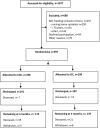Patterns of drug prescriptions in an orthogeriatric ward as compared to orthopaedic ward: results from the Trondheim Hip Fracture Trial-a randomised clinical trial
- PMID: 28550459
- PMCID: PMC5508046
- DOI: 10.1007/s00228-017-2263-x
Patterns of drug prescriptions in an orthogeriatric ward as compared to orthopaedic ward: results from the Trondheim Hip Fracture Trial-a randomised clinical trial
Abstract
Purpose: In the Trondheim Hip Fracture Trial, 397 home-dwelling patients with hip fractures were randomised to comprehensive geriatric care (CGC) in a geriatric ward or traditional orthopaedic care (OC). Patients in the CGC group had significantly better mobility and function 4 months after discharge. This study explores group differences in drug prescribing and possible associations with the outcomes in the main study.
Methods: Drugs prescribed at admission and discharge were registered from hospital records. Mobility, function, fear of falling and quality of life were assessed using specific rating scales. Linear regression was used to analyse association between drug changes and outcomes at 4 months.
Results: The mean age was 83 years, and 74% were females. The mean number (± SD) of drugs in the CGC and OC groups was 3.8 (2.8) and 3.9 (2.8) at inclusion and 7.1 (2.8) and 6.2 (3.0) at discharge, respectively (p = 0.003). The total number of withdrawals was 209 and 82 in the CGC and OC groups, respectively (p < 0.0001), and the number of starts was 844 and 526, respectively (p < 0.0001). A significant negative association was found between the number of drug changes during the hospital stay and mobility and function 4 months later in both groups. However, this association disappeared when adjusting for baseline function and comorbidities.
Conclusion: These secondary analyses suggest that there are significant differences in the pharmacological treatment between geriatric and orthopaedic wards, but these differences could not explain the beneficial effect of CGC in the Trondheim Hip Fracture Trial.
Keywords: Comprehensive geriatric care; Frail elderly; Geriatric assessment; Hip fracture; Pharmacotherapy; Polypharmacy.
Conflict of interest statement
Conflict of interest
The authors declare that they have no conflicts of interests.
Figures
References
-
- Bentler SE, Liu L, Obrizan M, Cook EA, Wright KB, Geweke JF, Chrischilles EA, Pavlik CE, Wallace RB, Ohsfeldt RL, Jones MP, Rosenthal GE, Wolinsky FD. The aftermath of hip fracture: discharge placement, functional status change, and mortality. Am J Epidem. 2009;170(10):1290–1299. doi: 10.1093/aje/kwp266. - DOI - PMC - PubMed
-
- Watne LO, Torbergsen AC, Conroy S, Engedal K, Frihagen F, Hjorthaug GA, Juliebo V, Raeder J, Saltvedt I, Skovlund E, Wyller TB. The effect of a pre- and postoperative orthogeriatric service on cognitive function in patients with hip fracture: randomized controlled trial (Oslo Orthogeriatric Trial) BMC Med. 2014;12(1):63. doi: 10.1186/1741-7015-12-63. - DOI - PMC - PubMed
-
- Rubenstein LZ, Wieland D, Bernabei R. Geriatric assessment technology: international research perspectives. Aging (Milano) 1995;7(3):157–158. - PubMed
Publication types
MeSH terms
LinkOut - more resources
Full Text Sources
Other Literature Sources
Medical


